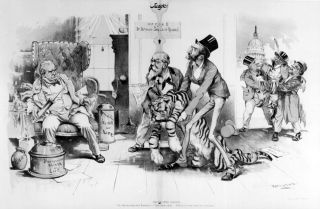Testosterone
Finding the Cure for Age in One Injection
Low-T, High-T, we keep repeating history
Posted March 18, 2014
In 1889, Dr. Charles-Edouard Brown Sequard, a neurologist in Paris, injected himself with a juice concocted from the testicles of guinea pigs and dogs. He said he never felt better. His urine jet stream quadrupled. His bowels moved regularly. One thing lead to another and next thing you know more than 10,000 American doctors were injecting men with testicle juice. Users said that, in addition to the reported excrement effects, they had better sex, bigger muscles and more energy. After that, a French doctor performed a scientific study on three 50-something men and they, too, said they felt better, confirming prior speculation. Dr. Brown-Sequard was 72 when he started injecting himself. He died five years later, slowing but not killing the 19th century rejuvenation business.
Next came Dr. John Brinkley, A.K.A., the goat gland doctor, who claimed to boost men’s sex drives by implanting goat testicles into them. Hoards of clients flocked to his home in Kansas, paid a hefty fee, and got to hand pick their testicles. (Pope Brock’s page-turning book, Charlatan tells the rags to riches story of John Brinkley). Brinkley touted huge success rates. Only about one or maybe two patients died. Survivors said they felt invigorated. The American Medical Association was irate.
You’ve got to wonder how much testosterone these men were getting and whether it did anything at all. Dr. Andrea Cussons, an endocrinologist in Australia certainly did. A few years ago, her team recreated the Brown-Sequard recipe, which entailed mashing with a mortal and pestle the testicles from five dogs—a Great Dane, a German Pointer, an Australian Shepherds, a Bull Terrior and a Papillon.
Then the scientists measured hormone levels, something 19th century doctors couldn’t do. Turns out that each shot contained about 112 nanograms of testosterone. A nanogram, as Aminoff points out, is a billionth of a gram, a dose far lower than given to seriously testosterone-deficient men.
So it comes as no surprise that with little evidence but lots of savvy marketing campaigns, that men today are bulking up with testosterone. (The latest issue of The Journal of American Nursing Practitioner has a review article by University of Pennsylvania’s Yaelim Lee who fills us in on what we do and don’t know about testosterone and androgen deficiency.) I wonder if the recent studies linking higher risk of heart problems with men taking testosterone will deter those who desperately feel they need a shot or a pill or some kind of quick fix to fire up their sexual juices. Or perhaps, enthusiasm for the Low-T cures will dampen in time for the sex-boosting, youth-enhancing panacea.

Urological Science Research Foundation


